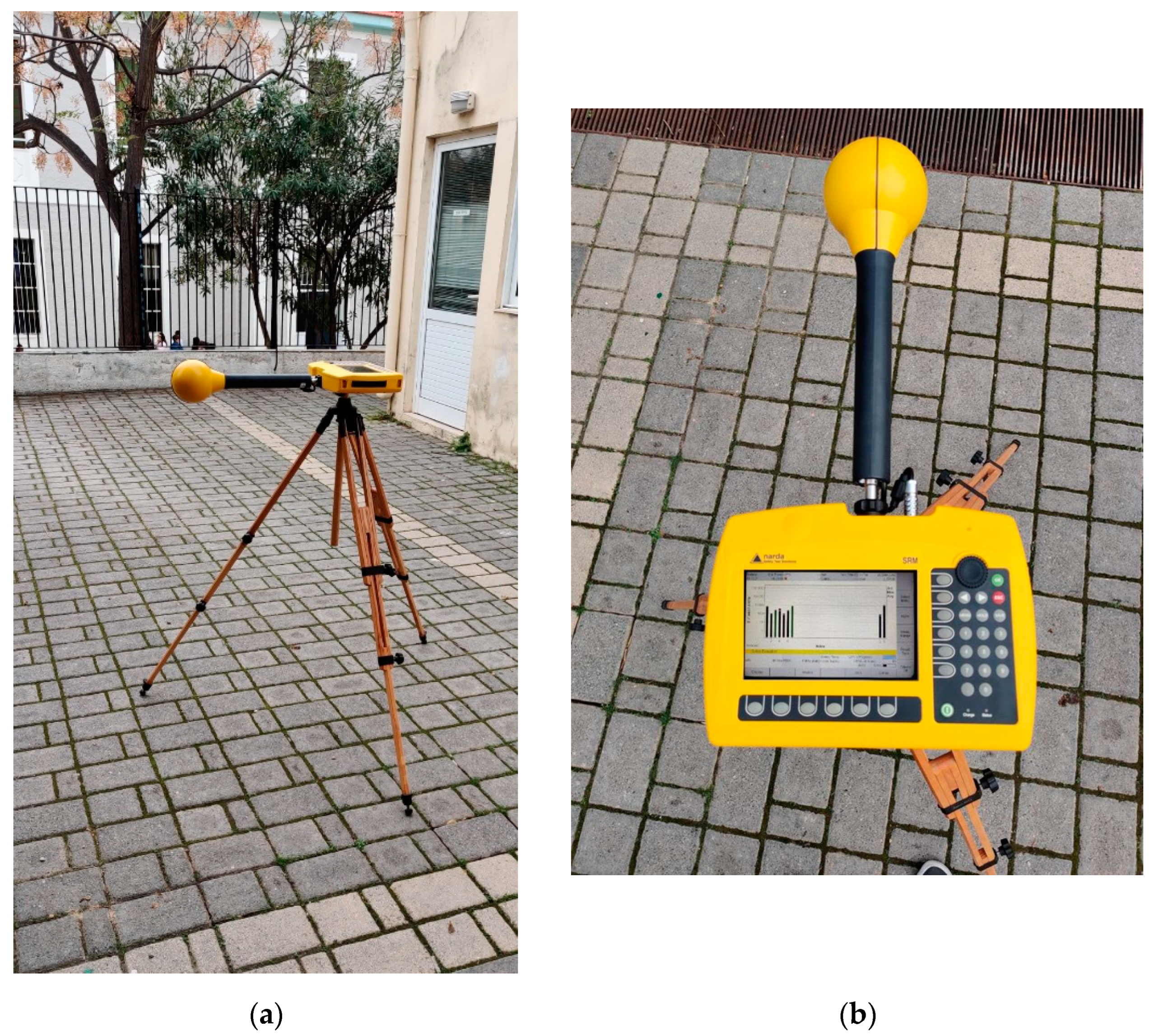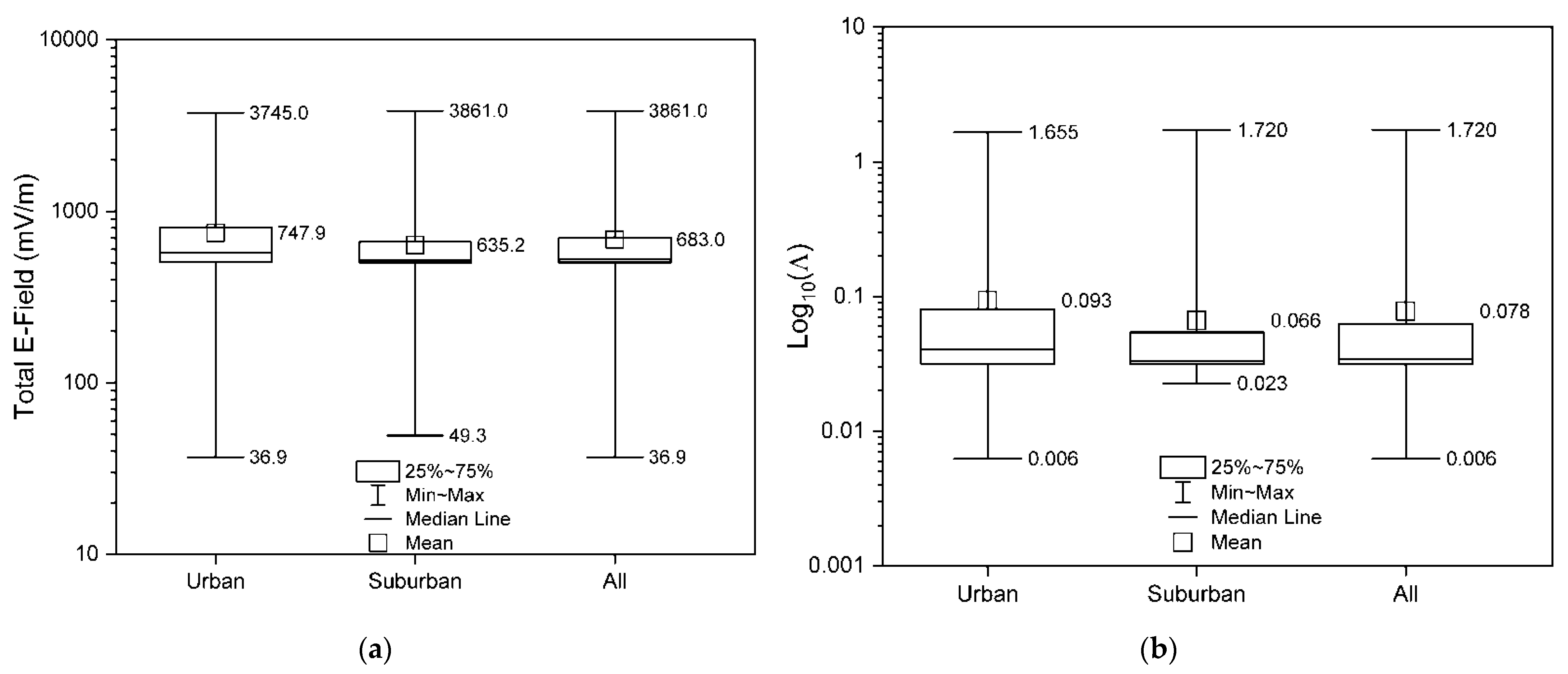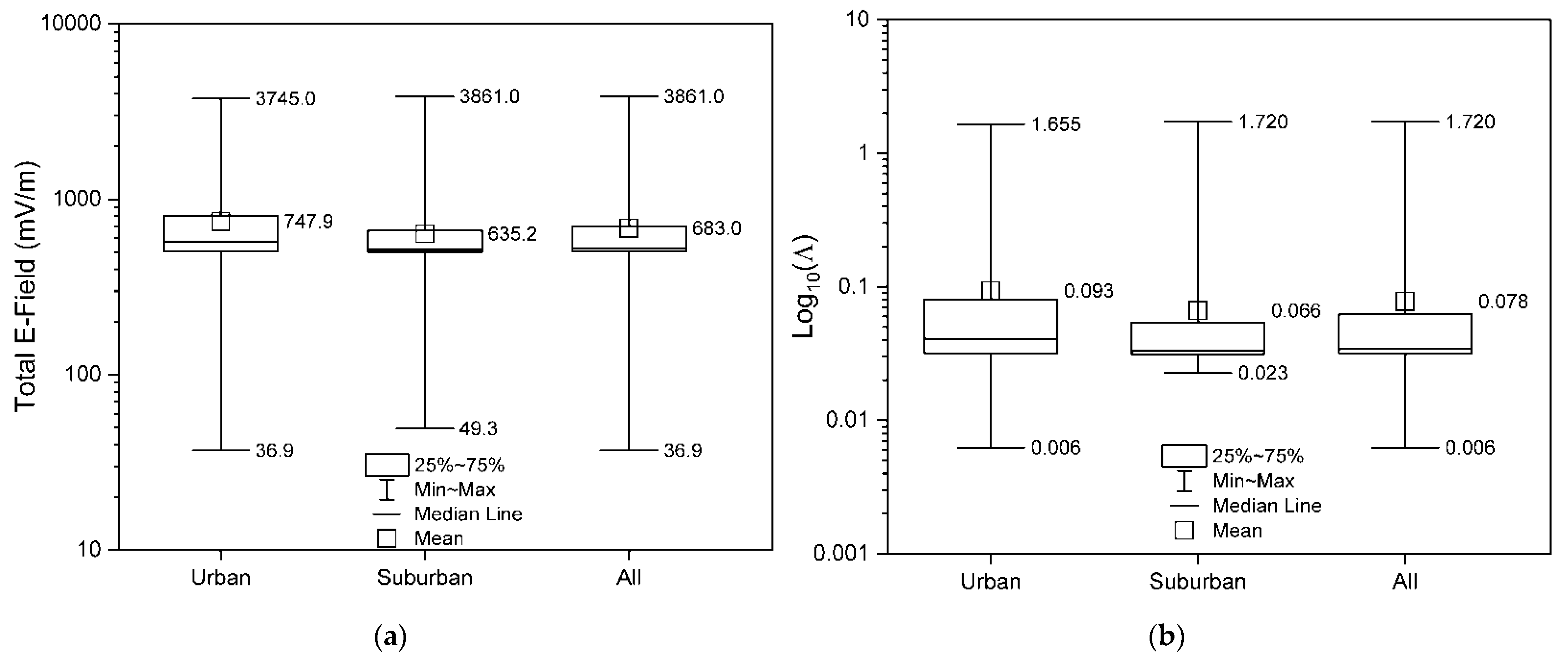Assessment of Radiofrequency Exposure in the Vicinity of School Environments in Crete Island, South Greece
Abstract
:1. Introduction
2. Materials and Methods
3. Results and Discussion
4. Comparisons
5. Conclusions
Author Contributions
Funding
Data Availability Statement
Conflicts of Interest
References
- Sagar, S.; Dongus, S.; Schoeni, A.; Roser, K.; Eeftens, M.; Struchen, B.; Meier, M.N.; Adem, S.; Roosli, M. Radiofrequency electromagnetic field exposure in everyday microenvironments in Europe: A systematic literature review. J. Expo. Sci. Environ. Epidemiol. 2018, 28, 147–160. [Google Scholar] [CrossRef] [PubMed]
- Jalilian, H.; Eeftens, M.; Ziaei, M.; Roosli, M. Public exposure to radio frequency electromagnetic fields in everyday microenvironments: An updated systematic review for Europe. Environ. Res. 2019, 176, 108517. [Google Scholar] [CrossRef] [PubMed]
- Bhatt, C.R.; Redmayne, M.; Billah, B.; Abramson, M.J.; Benke, G. Radiofrequency-electromagnetic field exposures in kindergarten children. J. Expo. Sci. Environ. Epidemiol. 2017, 27, 497–504. [Google Scholar] [CrossRef]
- Gallastegi, M.; Huss, A.; Santa-Marina, L.; Aurrekoetxea, J.J.; Guxens, M.; Birks, L.E.; Ibarluzea, J.; Guerra, D.; Roosli, M.; Jimenez-Zabala, A. Children’s exposure assessment of radiofrequency fields: Comparison between spot and personal measurements. Environ. Int. 2018, 118, 60–69. [Google Scholar] [CrossRef] [Green Version]
- Yener, S.C.; Cerezci, O.; Seker, S.S. Determination of the electromagnetic pollution in local school indoor and outdoor environments. IU-J. Electr. Electron. Eng. 2017, 17, 3509–3515. [Google Scholar]
- Birks, L.E.; Struchen, B.; Eeftens, M.; Van Wel, L.; Huss, A.; Gajsek, P.; Kheifets, L.; Gallastegi, M.; Dalmau-Bueno, A.; Estarlich, M.; et al. Spatial and temporal variability of personal environmental exposure to radio frequency electromagnetic fields in children in Europe. Environ. Int. 2018, 117, 204–214. [Google Scholar] [CrossRef] [PubMed] [Green Version]
- Vermeeren, G.; Markakis, I.; Goeminne, F.; Samaras, T.; Martens, L.; Joseph, W. Spatial and temporal RF electromagnetic field exposure of children and adults in indoor micro environments in Belgium and Greece. Prog. Biophys. Mol. Biol. 2013, 113, 254–263. [Google Scholar] [CrossRef] [PubMed] [Green Version]
- Van Wel, L.; Vermeulen, R.; Eijsden, M.; Vrijkotte, T.; Kromhout, H.; Huss, A. Radiofrequency exposure levels in Amsterdam schools. Bioelectromagnetics 2017, 38, 397–400. [Google Scholar] [CrossRef] [PubMed]
- Verloock, L.; Joseph, W.; Goeminme, F.; Martens, L.; Verlaek, M.; Constandt, K. Temporal 24-hour assessment of radio frequency exposure in schools and homes. Measurement 2014, 56, 50–57. [Google Scholar] [CrossRef] [Green Version]
- Christopoulou, M.; Karabetsos, E. Evaluation of radiofrequency and extremely low-frequency field levels at children’s playground sites in Greece from 2013 to 2018. Bioelectromagnetics 2019, 40, 602–605. [Google Scholar] [CrossRef] [PubMed]
- Kiouvrekis, Y.; Manios, G.; Tsitsia, V.; Goulzoulidis, G.; Kappas, G. A statistical analysis for RF-EMF exposure levels in sensitive land use: A novel study in Greek primary and secondary education schools. Environ. Res. 2020, 191, 109940. [Google Scholar] [CrossRef] [PubMed]
- Gotsis, A.; Papanikolaou, N.; Komnakos, D.; Yalofas, A.; Constantinou, P. Non-ionizing electromagnetic radiation monitoring in Greece. Ann. Telecommun. 2008, 63, 109–123. [Google Scholar] [CrossRef]
- Manassas, A.; Boursianis, A.; Samaras, T.; Sahalos, J.N. Continuous electromagnetic radiation monitoring in the environment: Analysis of the results in Greece. Radiat. Prot. Dosim. 2012, 151, 437–442. [Google Scholar] [CrossRef] [PubMed]
- Christopoulou, M.; Karabetsos, E. In situ measurements of radiofrequency exposure levels in Greece from 2008 to 2013: A multi-parametric annual analysis. Bioelectromagnetics 2015, 36, 325–329. [Google Scholar] [CrossRef] [PubMed]
- Karastergios, I.; Gialofas, A.; Karabetsos, E. National observatory of electromagnetic fields: National telemetric network for the measurement of high-frequency electromagnetic fields in Greece. Radiat. Prot. Dosim. 2020, 188, 413–423. [Google Scholar] [CrossRef] [PubMed]
- Gourzoulidis, G.A.; Tsaprouni, P.; Skamnakis, N.; Tzoumanika, C.; Kalampaliki, E.; Karastergios, I.; Gialofas, A.; Achtipis, A.; Kappas, C.; Karabetsos, E. Occupational exposure to electromagnetic fields. The situation in Greece. Phys. Med. 2018, 49, 83–89. [Google Scholar] [CrossRef] [PubMed]
- Narda Safety Test Solutions. Selective Measurement of High Frequency Electromagnetic Fields; Selective Radiation Meter SRM-3006. NSTS 0321-E0272L; Narda Safety Test Solutions GmbH: Pfullingen, Germany, 2012. [Google Scholar]
- Narda Safety Test Solutions. Accounting for Measurement Uncertainty in the SRM-3000; Application Note. AN_HF_1004_Measurement_Uncertainty; Narda Safety Test Solutions GmbH: Pfullingen, Germany, 2007. [Google Scholar]
- International Electrotechnical Commission (IEC). BS IEC 62232:2011. Determination of RF Field Srength and SAR in the Vicinity of Radiocommunication Base Stations for the Purpose of Evaluating Human Exposure; BSI Standards Publication: London, UK, 2011. [Google Scholar]
- CENELEC TC 106x European Committee for Electrotechnical Standardisation. Electromagnetic Fields in the Human Environment. EN 50492:2008/A1:2014. Basic Standard for the In-Situ Measurement of Electromagnetic Field Strength Related to Human Exposure in the Vicinity of Base Stations; European Committee for Electrotechnical Standardisation: Brussels, Belgium, 2014. [Google Scholar]
- International Commission of Non Ionizing Radiation Protection (ICNIRP). Guidelines for limiting exposure to time varying electric, magnetic and electromagnetic fields (up to 300 GHz). Health Phys. 1998, 74, 494–522. [Google Scholar]
- Act, No. 1105. Common Ministerial Order of the Ministries of Development, Transport and Communications, Health and Environment, Physical Planning and Public Works. Measures for the Protection of the General Public from the Operation of Land Based Antenna Stations; Articles 2–4, Act No.1105/Vol.B/6-9-2000; Hellenic Republic: Athens, Greece, 2000. (In Greek) [Google Scholar]
- Law No 4070. Electronic Communications, Public Works and Other Provisions; Article 30, par. 9–10, Official Gazette 82/A/10-4-2012; Hellenic Republic: Athens, Greece, 2012. (In Greek) [Google Scholar]
- Council of the European Union. 1999/519/EC. Council Recommendation of 12 July 1999 on the Limitation of Exposure of the General Public to Electromagnetic Fields (0 Hz to 300 GHz). Off. J. Eur. Communities 1999, 199, 59–70. [Google Scholar]






| Frequency Band (MHz) | E-Field ( ) (mV/m) | Exposure Ratio ( ) | Mood’s Test | ||||||||
|---|---|---|---|---|---|---|---|---|---|---|---|
| Min | Max | Mean | SD | Median | Min | Max | Mean | SD | Median | p-Value | |
| 27–879 | 36.93 | 2382.0 | 444.15 | 259.14 | 344.00 | 0 | 1.250 | 0.058 | 0.119 | 0.026 | 0.155 |
| 879.1–961 | 34.17 | 316.3 | 65.75 | 42.90 | 48.26 | 0 | 0.010 | 0.001 | 0.001 | 0.000 | 0.004 |
| 961–1709 | 61.32 | 963.0 | 175.04 | 104.95 | 134.65 | 0 | 0.085 | 0.004 | 0.008 | 0.002 | 0.042 |
| 1709.1–1881 | 30.32 | 1070.0 | 112.19 | 99.54 | 77.93 | 0 | 0.059 | 0.001 | 0.004 | 0.000 | 0.042 |
| 1881.1–1919 | 29.05 | 275.5 | 47.11 | 29.04 | 36.06 | 0 | 0.004 | 0.000 | 0.000 | 0.000 | 0.042 |
| 1919.1–2171 | 92.65 | 902.2 | 156.10 | 101.62 | 115.80 | 0 | 0.037 | 0.002 | 0.004 | 0.001 | 0.012 |
| 2171.1–3000 | 19.93 | 2482.0 | 441.88 | 272.71 | 336.35 | 0 | 0.277 | 0.012 | 0.026 | 0.005 | 0.042 |
| Total | 36.93 | 3861.0 | 683.03 | 418.38 | 524.15 | 0.006 | 1.720 | 0.078 | 0.162 | 0.034 | 0.042 |
| Frequency Range | E-Field Strength (V/m) |
|---|---|
| 1–3 kHz | 150/f |
| 3 kHz–1.43 MHz | 52.2 |
| 1.43–10 MHz | 67.3/f |
| 10–400 MHz | 21.7 |
| 400–2000 MHz | 1.065∙f1/2 |
| 2–300 GHz | 47.2 |
| Environment | Distribution | Parameter | Estimated Value |
|---|---|---|---|
| Urban | Lognormal | µ (mean) | 6.49 |
| σ (standard deviation) | 0.48 | ||
| Gamma | α (shape alpha) | 4.19 | |
| θ (scale thita) | 178.5 (deg) | ||
| Weibull | α (scale alpha) | 846.87 | |
| β (shape beta) | 1.77 | ||
| Normal | µ (mean) | 747.90 | |
| σ (standard deviation) | 469.06 | ||
| Suburban | Lognormal | µ (mean) | 6.37 |
| σ (standard deviation) | 0.37 | ||
| Gamma | α (shape alpha) | 6.37 | |
| θ (scale thita) | 99.79 (deg) | ||
| Normal | µ (mean) | 635.22 | |
| σ (standard deviation) | 370.55 |
| Environment | Distribution | Parameter | Estimated Value |
|---|---|---|---|
| Urban | Lognormal | µ (mean) | −2.91 |
| σ (standard deviation) | 0.85 | ||
| Gamma | α (shape alpha) | 1.07 | |
| θ (scale thita) | 0.09 (deg) | ||
| Weibull | α (scale alpha) | 0.09 | |
| β (shape beta) | 0.91 | ||
| Normal | µ (mean) | 0.09 | |
| σ (standard deviation) | 0.17 | ||
| Suburban | Lognormal | µ (mean) | −3.13 |
| σ (standard deviation) | 0.65 | ||
| Gamma | α (shape alpha) | 1.35 | |
| θ (scale thita) | 0.05 (deg) | ||
| Normal | µ (mean) | 0.07 | |
| σ (standard deviation) | 0.15 |
| Frequency Band (MHz) | Exposure Ratio () | Mood’s Test | ||
|---|---|---|---|---|
| Mean | SD | Median | p-Value | |
| 27–879 | 0.114 | 0.225 | 0.033 | 0.404 |
| 879.1–961 | 0.001 | 0.002 | 0.001 | 0.186 |
| 961–1709 | 0.008 | 0.015 | 0.002 | 0.404 |
| 1709.1–1881 | 0.003 | 0.009 | 0.001 | 0.729 |
| 1881.1–1919 | 0.000 | 0.001 | 0.000 | 0.186 |
| 1919.1–2171 | 0.003 | 0.007 | 0.001 | 0.186 |
| 2171.1–3000 | 0.024 | 0.050 | 0.007 | 0.404 |
| Total | 0.154 | 0.308 | 0.044 | 0.404 |
| Study | Micro- Environment | Location | Frequency Range | Equipment | Median (Total, All Bands) | Highest Measured Value | Main Contributors to the Total Exposure | Excess of Local Reference Levels |
|---|---|---|---|---|---|---|---|---|
| [12] | 46 continuous monitoring stations (urban, rural) | Sites all over Greece | 100 kHz–3 GHz | EM radiation monitoring networks comprising spectrum analyzers, selective radiation meters, isotropic E-field sensors, control and storage units, etc. | - (mean values: 0.03–3.93 V/m depending on the location) | - | Mobile communication frequencies and broadcast | No (regarding the mean measured electric field strength) |
| [13] | 90 continuous monitoring stations (urban, rural) | Sites all over Greece | 100 kHz–3 GHz and 3 sub–bands 925–960 MHz, 1805–1880 MHz, 2110–2170 MHz | EM radiation monitoring networks comprising spectrum analyzers, selective radiation meters, isotropic E-field sensors, control and storage units, etc. | 1100 mV/m (urban) 300 mV/m (rural) | 4.83 V/m | Mobile communication frequencies and broadcast | No (regarding the total exposure ratio) |
| [15] | 489 monitoring stations | 273 municipalities all over Greece | 100 kHz–7 GHz | Broadband Narda AMB-8057-03/G-type EMF monitoring station | - (91% of the annual average values < 2 V/m) | - (20% of the annual maximum values > 2 V/m) | - | No |
| [14] | 4705 audits in the vicinity of base stations (urban, suburban, rural) | Sites all over Greece | 27–3000 MHz (8 bands) | Selective radiation meter SRM-3006 with isotropic E-field antenna (Narda) | - (mean value: 2.24 V/m) | 14 V/m (1% of measurements) | Mobile communication frequencies and broadcast | No (regarding the total exposure ratio), occasionally yes |
| [3] | 20 kintergardens | Melbourne, Australia | 88–5800 MHz (16 bands) | Exposimeter ExpoM-RF 64 (Fields at Work) | 233 mV/m | - | GSM-900 downlink | No |
| [5] | 24 primary schools | Nilüfer, Bursa, Turkey | RF (especially GSM bands) and ELF | Selective radiation meter SRM-3006 and isotropic EM-field meter (Narda) | - | 3–4 V/m (4.2% of measurements) | GSM frequencies (900, 1800, 2100 MHz) | No |
| [4] | 26 school playgrounds and 79 parks | Basque country, Spain | 87.5–6000 MHz (16 bands) | Exposimeter with 3-axis isotropic antenna | 275 mV/m (playgrounds) 216 mV/m (parks) * | 2.36 V/m * | Broadcast and mobile phone downlink | - |
| [10] | 317 playgrounds (urban and suburban) | 16 municipalities in Greece | 27–3000 MHz | Selective radiation meter SRM-3006 with isotropic E-field antenna (Narda) | 244 mV/m (urban) 229 mV/m (suburban) | 1.66 V/m | - | No (regarding the total exposure ratio) |
| [11] | 65 schools (urban) | Greece | 27–3000 MHz | Selective radiation meter SRM-3006 with isotropic E-field antenna (Narda) | 403 mV/m | 1.35 V/m | - | No |
| Current study | 69 nursery and primary schools (urban and suburban) | Chania, Crete island, Greece | 27–3000 MHz (7 bands) | Selective radiation meter SRM-3006 with isotropic E-field antenna (Narda) | 576 mV/m (urban) 516 mV/m (suburban) | 3.86 V/m | Mobile communication frequencies and broadcast | No (regarding the total exposure ratio), occasionally yes |
Publisher’s Note: MDPI stays neutral with regard to jurisdictional claims in published maps and institutional affiliations. |
© 2022 by the authors. Licensee MDPI, Basel, Switzerland. This article is an open access article distributed under the terms and conditions of the Creative Commons Attribution (CC BY) license (https://creativecommons.org/licenses/by/4.0/).
Share and Cite
Kapetanakis, T.N.; Ioannidou, M.P.; Baklezos, A.T.; Nikolopoulos, C.D.; Sergaki, E.S.; Konstantaras, A.J.; Vardiambasis, I.O. Assessment of Radiofrequency Exposure in the Vicinity of School Environments in Crete Island, South Greece. Appl. Sci. 2022, 12, 4701. https://doi.org/10.3390/app12094701
Kapetanakis TN, Ioannidou MP, Baklezos AT, Nikolopoulos CD, Sergaki ES, Konstantaras AJ, Vardiambasis IO. Assessment of Radiofrequency Exposure in the Vicinity of School Environments in Crete Island, South Greece. Applied Sciences. 2022; 12(9):4701. https://doi.org/10.3390/app12094701
Chicago/Turabian StyleKapetanakis, Theodoros N., Melina P. Ioannidou, Anargyros T. Baklezos, Christos D. Nikolopoulos, Eleftheria S. Sergaki, Antonios J. Konstantaras, and Ioannis O. Vardiambasis. 2022. "Assessment of Radiofrequency Exposure in the Vicinity of School Environments in Crete Island, South Greece" Applied Sciences 12, no. 9: 4701. https://doi.org/10.3390/app12094701
APA StyleKapetanakis, T. N., Ioannidou, M. P., Baklezos, A. T., Nikolopoulos, C. D., Sergaki, E. S., Konstantaras, A. J., & Vardiambasis, I. O. (2022). Assessment of Radiofrequency Exposure in the Vicinity of School Environments in Crete Island, South Greece. Applied Sciences, 12(9), 4701. https://doi.org/10.3390/app12094701









